If you were a serious comic book collector in the 1960s there was a good chance you were eventually drawn into the wonderful world of comic book fanzines. A fanzine is a magazine style publication produced usually by amateur writers and artists to honor and pay homage to their chosen hobby. And the fanzines created by comic book fans in those days were brimming with vitality, passion and pure entertainment. They were exciting enough when you were an innocent kid in the 1960s. When I look at them now from the year 2012 as a jaded adult I feel waves of nostalgia washing over me and sweeping me back to that unique time in my life.
Rocket's Blast - Comicollector

For me, the center of that intoxicating whirlpool of nostalgia is The Rocket’s Blast – Comicollector or RB&CC. It was the leading comic book fanzine in the mid to late 1960s with the largest circulation. It’s circulation of about 1600 to 2000 per issue was a rounding error to any regular newsstand magazine like Time or TV Guide. But for a magazine devoted to a miniscule population (that weird, suspect American subculture known as comic book collectors), that was a pretty good circulation. RB&CC was published by G.B. Love in Miami, Florida. Some of its early writers and contributors were well known comic book collectors and historians like Raymond Miller, Buddy Saunders, Jerry Bails, and Howard P. Siegel. One of its later editors, Jim Van Hise, is still active today writing popular culture articles. Most of RB&CC was classified and display advertisements for back issue comic books, pulps, original comic book and comic strip art, and old radio and TV shows on tape. It also liked to run reprinted articles about comic books that appeared in regular newspapers and magazines. About 15% of each issue had articles and columns about collecting all this great stuff or the current comic book scene written by its staff and contributors.
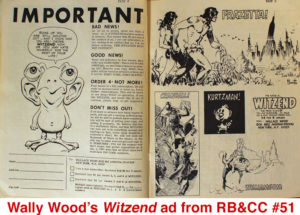
I came across an ad for RB&CC in the classified ads in Marvel comics and my curiosity got the best of me. I subscribed for a few issues in 1966. My first issue, #51, sucked me in right away. The cover had a nice tribute to Walt Disney who had just recently passed away. There was an interesting article about collecting old comics by “Russell V. Cochran, Ph.D.” Yes, that’s the same Russ Cochran who published all those EC comic reprints in the 1980s and 1990s and ran all those original art auctions which very few fans could afford to bid in. A two page ad for a new art fanzine by Wally Wood named Witzend caught my eye. I wish now I had paid the $1.00 per issue back then instead of having to chase them down on ebay now for $80.00 each. But $1.00 was a hefty sum in those days. Heck, you buy eight Marvel comic books with change left over for $1.00 and Marvel comics took priority over all else.
My favorite column was “Comic Collector’s Comments” by Howard P. Siegel who I imagined then must have been a full fledged adult. He had a lucid professional writing style that no fanboy teenager could manage. Siegel had a humorous feud with another columnist, Raymond Miller and Siegel always referred to Miller as Raymond “Who?” Miller. It was Miller however who actually later helped me out. I was starting to collect EC comics in the early 1970s and Miller had a column where you could write in and ask questions about old comics. I was wondering why the EC science fiction comic, Weird Science had two #12 issues and Weird Fantasy had two #13 issues. There was no Overstreet Price Guide then to explain such things so I wrote in and asked Miller. He didn’t include my letter in his column but he sent me a nice handwritten note explaining the mystery.
Of course I didn’t subscribe to RB&CC just for the articles. I was mostly looking to buy back issue Marvel and EC comics and some of the advertisers were able to help me out. Today in A.D. 2012, one of the most shocking experiences is to look at the prices for old comic books in the 1960s compared to the astronomical prices of today. Of course the prices in the 1960s seemed high to me as a kid with no full time job and an allowance that was never more than $3.00 a month. Take a look at this ad from RB&CC #57 for a complete set of high grade Marvel comics for $400.00. To me, $400.00 in the late 1960s seemed as unreachable as $4,000,000,000 does today.
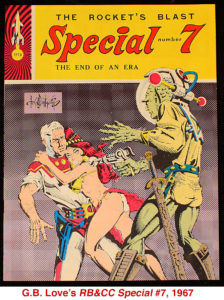

I think RB&CC’s most important legacy for me is that it got me started collecting EC comics. I was vaguely aware of EC comics from comic dealer price lists but I knew almost nothing about them until that RB&CC #51 arrived in the mail in 1966. Each issue always had ads selling old ECs. Their were occasional alluring art samples showing off the artists Wally Wood, Reed Crandall, Al Williamson and references gushing about how great the EC comic books were. One of these references was an ad for a special edition RB&CC’s produced fanzine The Rocket’s Blast Special #7 The End Of A Era which helped fuel my curiosity over all the fuss about EC. So over the next few years the accumulated publicity and exposure to EC through the pages of RB&CC led me circa to 1970 to bite the financial bullet and start collecting EC in addition to my beloved Marvels. I’ll always be grateful to RB&CC for that alone. I don’t have that many issues of RB&CC and one of these days if I can cobble together the money I’d like to put together a longer run of RB&CC. But like everything else from the 1960s and early 1970s, they are getting more expensive and harder to find.
The Other Guys
I addition to RB&CC’s I did pick up a few other fanzines, mostly from ads I saw in RB&CC. One was Fantasm #2. I don’t remember now why I ordered it. It didn’t have any articles on Marvel comics, just articles on The Justice League of America from DC and Magnus Robot Fighter from Gold Key, neither of which I collected.
I did subscribe for a year to a fanzine dedicated exclusively to Marvel Comics, Marvel Mirror. The first issues were from 1967 so this is a very early Marvel oriented fanzine. It was lithographed (not mimeographed like the cheaper fanzines) and had well written articles by its college student publisher Greg Kishel. Its top artist was Dave Russell who could copy Jack Kirby as well as the rest of army of amateur fanzine artists who copied Jack Kirby in those days. Some of its contributors were Big Name Fans like Dwight Decker and two others who later went professional in the comics or animation business, Tony Isabella and Mark Evanier.
My favorite column was Tony Isabella’s “Marvel’s Back Pages” which did reviews of 1950s Atlas comics. Some of the these reviews that I liked were of the 1956 Atlas comic The Yellow Claw from combined issue #3 and 4; the 1957 Atlas Western comic The Black Rider #1 from issue #6; the 1957 pre-Marvel Strange Worlds #1 from issue #7. I was intrigued by Isabella’s praise of the best story in Strange Worlds #1, “I Am Robot” which Isabella claimed would have been a top EC story if they done it. Isabella also said the robot “ranked” with the robots in Isaac Asimov’s novels and Robbie from the Otto Binder novel. Isabella and Evanier are still active today. Does anybody know what happened to Kishel or Decker? Have they faded completely into the oblivion of lost comic fandom history?
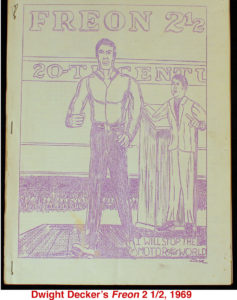

Most fanzines were ephemeral affairs and Marvel Mirror fit the pattern. It vanished after about a year and left some of its subscribers like me short an issue. But all was not lost; shortly afterward an issue of editor Dwight Decker’s mimeographed fanzine Freon arrived unsolicited in the mail. Decker’s editorial said he had inherited the former fanzine’s subscription list. I hadn’t read this Freon fanzine since 1969 but I was struck now in 2012 at how well written it is. It’s mostly political editorials instead of comic related articles but they are well written on a college level. Dwight Decker’s article on the Allen Drury best selling political book Advise And Consent is interesting to me now at age 59. I read that book about 1980 and enjoyed the movie version, but in 1969 at age 15 I cared little about reviews of political books so I didn’t subscribe to Freon. But it is still an example of the intellectual ferment that was bubbling in comic fandom in the late 1960s but unknown to the outside world. Freon was a cheaply made mimeographed pamphlet with staples but had insightful adult articles that would hold up fairly well if published in a fancy academic journal written by college professors.
The Buyer's Guide For Comic Fandom
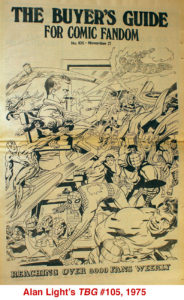
I don’t remember how I first learned of The Buyer’s Guide For Comic Fandom aka TBG. I may have seen an ad in a Marvel comic for it and sent off for a sample issue. Its also possible a free sample issue arrived in the mail and I liked it enough to start subscribing. TBG started in 1971 and I have a collection for the five years I subscribed to it, 1972 – 1975. TBG quickly asserted itself as the primary advertising fanzine, replacing RB&CC’s which I believe moved more to articles instead of mostly ads. TBG was a large newspaper style format in folded sections. Each cover had an original art illustration by amateur artists and sometimes a professional artist. Its editor was a young man named Alan Light who I believe became a music critic in Los Angeles. I remember seeing in a 1980s issue of TBG’s successor, CBG, some photos Light sent in of him in a tuxedo serving as a limousine door opener at the Oscar ceremonies in Hollywood. TBG’s only regular columnists at first was Light’s assistant Murray Bishoff and a fanzine editor Martin Greim. Later, two professional newspaper reporters, Don and Maggie Thompson, had a column named “Beautiful Balloons” which mostly reviewed current comic books and fanzines. TBG by the mid 1970s had a circulation of over 8,000, way more than RB&CC ever had on its best day.
My subscription expired circa 1975 and I joined the Air Force in 1977 so I don’t know when exactly Alan Light sold out to a collectibles publishing company, Krause Publications. Don and Maggie Thompson became the editors of the newly named The Comics Buyer’s Guide aka CBG which is still in business today in a magazine format. Sometime in the early 1980s I ended up subscribing to CBG for several years. I didn’t save any of my many 1980s CBG issues, but I did save most of my TBG issues from 1971 – 1975. If anybody wants to get a feel for what collecting old comic books was like in the 1970s, an excellent way is to look through these old issues of TBG. Since that would be difficult for most people I’ve included two lists of photos below. Click the links.
The second list has photos from The Buyers Guide of full page advertisements for comic book conventions.
Most of the artists and writers who created the comic book industry in the 1940s were still alive in the 1970s and attended comic book conventions to meet with the fans. It’s fun to see their names listed in these ads and a bit sad to reflect that fans today don’t have the privilege to mingle with these legendary founding fathers.

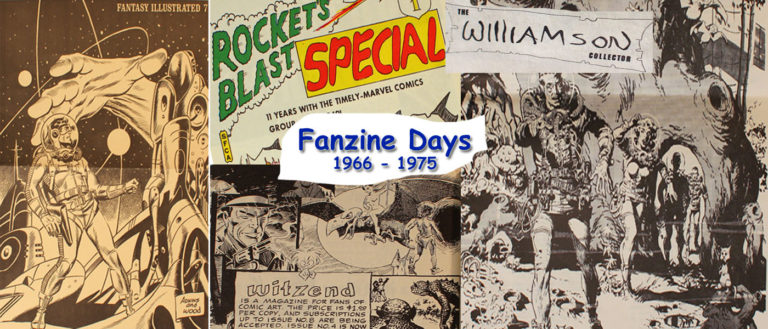
A nice piece of nostalgic journalism. Thanks!